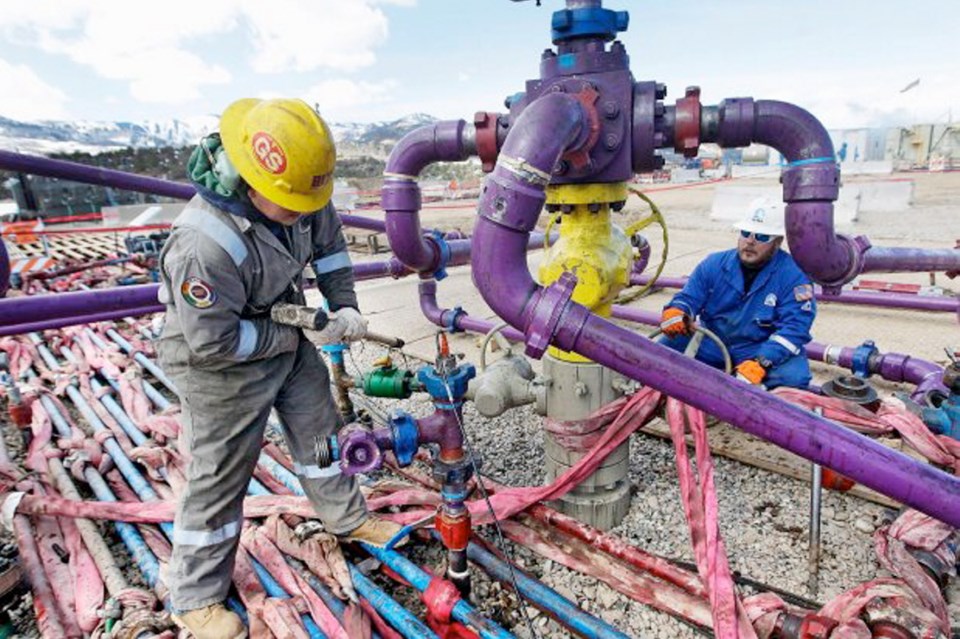Toxic waste water equal in volume to 24 World Trade Center towers has been injected into a single 46-year-old natural gas well in northeastern British Columbia, says a report for the Fort Nelson First Nation done by the University of Victoria’s Environmental Law Centre.
More than 41 billion litres of water too contaminated for surface disposal has been injected into the well — identified as Well #2240 — since 1968.
“Because waste water is not tracked after disposal,”�� the study says, “the fate of this massive quantity of waste water is unknown.”
It warns that B.C.'s regulatory framework governing safe disposal of the more than 100 billion litres of such contaminated waste water generated during B.C.’s rapidly expanding fracking operations to recover natural gas is clearly inadequate�� and says regulation lags behind standards in the United States, Europe and Australia.
The assertions contradict B.C.’s minister of natural gas, Rich Coleman, who said in March that the province leads in safe, responsible natural gas development and has some of the world’s strictest rules for water use and protection.
Coleman said water used in fracking is carefully monitored by the B.C. Oil and Gas Commission.
However, the report says that when it asked about a specific annual test for well integrity required under provincial regulations, researchers were told the commission was reviewing all 110 disposal wells to determine when the mandatory test was last done.
“Serious questions have been raised about B.C.’s retreat from vigorous environmental regulation efforts over the last decade,” the report says. Since 1998, it notes, Ministry of Environment staff has been reduced by 25 per cent; between 2001 and 2008 mine inspections decreased by 50 per cent; and a 2009 review showed environmental convictions dwindling to the fewest in 20 years.
Fracking injects large volumes of hydraulic fluid�� water treated with chemical and other additives���� into underground shale formations. Rock shatters and natural gas is released. The technology has triggered a global natural gas boom.
The process can mean repeat injections of up to 20,000 cubic metres of hydraulic fluid into a well. Most fracking fluid remains in the well, but significant quantities of contaminated water flow back out during production. This toxic fluid sometimes brings up natural radioactive material.
One New York state study found radioactivity in fracking waste water at 267 times the level considered safe for human consumption. Other studies found several cancer-causing contaminants in fracking waste water. The report cites arsenic, lead, hexavalent chromium, barium, chloride, sodium, sulfates, boron, benzene and radioactive agents.
The Fort Nelson First Nation is worried because three of British Columbia’s four major shale gas plays occur within its territory. Planned expansion to achieve B.C.’s liquefied natural gas strategy will require fracking operations there to increase 600 times.
The First Nation is apprehensive about safe disposal of contaminated fracking water and possible hazards for human health and the environment.
B.C. s regulations ban discharge into water bodies or on land, so toxic waste water here is re-injected into underground disposal wells.
“These wells are typically old wells whose integrity and operation are poorly monitored,” the report says. Concerns include surface spills during re-injection; improper seals in old cement around well casings permitting toxic leaks into shallow aquifers; migration of water upward from deep wells to contaminate shallow and surface groundwater travelling through subterranean rock layers.
Fracking and disposal well injection may also trigger small earthquakes and more sub-surface fractures by which contaminated water can migrate away from injection sites.
“Although B.C. currently regulates some aspects of waste water disposal wells, the regulatory framework is insufficient,” the study says. Current legislation must be strengthened to provide adequate assurances that disposal wells will not contaminate drinking water and surface water systems.
It calls for the province to beef up legislation governing disposal methods and structural, hydro-geological and environmental integrity for disposal sites; safe location of disposal sites away from potential contamination of ground and surface water; long-term monitoring and compliance enforcement and a robust emergency response plan.
��
����



